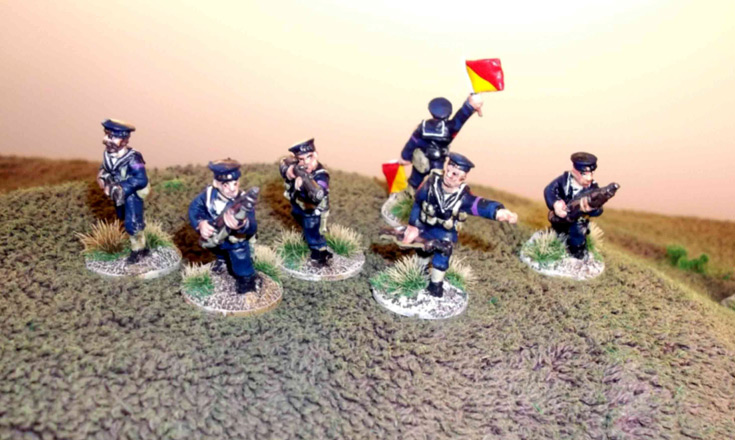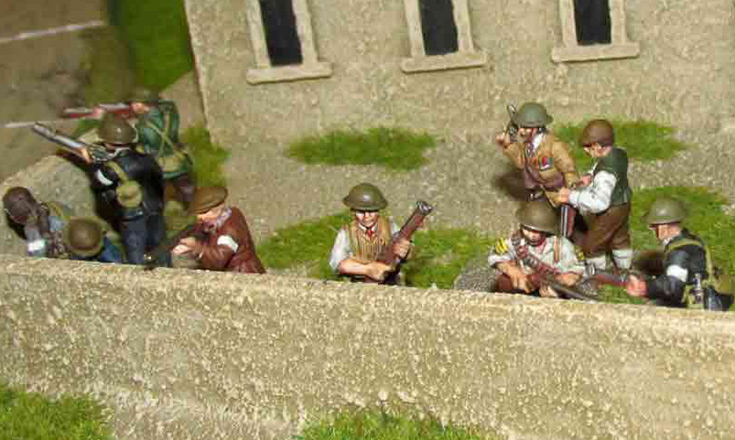
Skirmish at Kirbuster, 1936
12th September 2012, 0 Comments
A Very British Civil War, Triumph & Tragedy, 28mm
I was recently talked into taking on the “Very British Civil War” (VBCW) as a “period”, and I decided to set it in Orkney. After all, the islands are custom-built for a mini-campaign, and it’s always fun fighting over a landscape you know. You can read the back story from the link below, but as a background for this game the Navy (pro-Prince Albert) have established a mainland base at Houton in Orphir, and have been sending out patrols along the road leading to Kirkwall. That’s the island’s main town where the Royalists (pro-Edward VIII forces) are based. This game involved a clash between one such naval patrol and a motorised force sent out from Kirkwall. The scene was set for a small skirmish, fought out near Kirbister in Orkney. Not only was this the opening clash of the Civil War in Orkney, but we also used the game as an excuse to try out a set of rules – Triumph & Tragedy. I commanded the Royalists, while Chris Werb took charge of the Albertine sailors and marines. Here’s what happened; The naval force commanded by Lt. Cdr. Dorien-Gray was split into three- one section held the Kirbister bridge, a second scouted ahead by climbing Hobister Hill while the third – a detachment of Royal Marines – remained in reserve off table. They boasted the only truck in the force. The sailors on the hill signalled the approach of a column of Royalist trucks. Dorien-Gray was under orders to open fire if his sailors were threatened, and he clearly saw these trucks as a distinct threat. The column was led by a motorcycle, followed by three trucks. On Turn 1 the motorcycle continued down the road unscathed, but the sailors on the hill opened fire on the lead truck, and it veered off the road. The die was cast, and now both sides had nothing to lose but to rip into each other. Nobody in the truck was hurt, but its engine was hissing steam, so it pulled off the road and stopped beside a stone dyke. The sailors then fired on the second truck, killing the driver and peppering the radiator. It ground to a halt and the passengers – a detachment of Police Auxiliaries. They returned fire, but when the sailors on the bridge advance to within range they found themselves outnumbered and outshot. Soon only the sergeant remained alive, and he fled back to join the remaining Auxiliary unit.
The naval force commanded by Lt. Cdr. Dorien-Gray was split into three- one section held the Kirbister bridge, a second scouted ahead by climbing Hobister Hill while the third – a detachment of Royal Marines – remained in reserve off table. They boasted the only truck in the force. The sailors on the hill signalled the approach of a column of Royalist trucks. Dorien-Gray was under orders to open fire if his sailors were threatened, and he clearly saw these trucks as a distinct threat. The column was led by a motorcycle, followed by three trucks. On Turn 1 the motorcycle continued down the road unscathed, but the sailors on the hill opened fire on the lead truck, and it veered off the road. The die was cast, and now both sides had nothing to lose but to rip into each other. Nobody in the truck was hurt, but its engine was hissing steam, so it pulled off the road and stopped beside a stone dyke. The sailors then fired on the second truck, killing the driver and peppering the radiator. It ground to a halt and the passengers – a detachment of Police Auxiliaries. They returned fire, but when the sailors on the bridge advance to within range they found themselves outnumbered and outshot. Soon only the sergeant remained alive, and he fled back to join the remaining Auxiliary unit. While this was going on the remaining two trucks disgorged their passengers – a second detachment of Auxiliaries and a unit of the Kirkwall Police – men of the Orkney Constabulary. They also had a detachment of two Lewis Guns manned by the Auxiliaries and the Orkney Territorial Army (TA). While they began firing at the sailors on Hobister Hill, Commissioner Spence gathered the rest of the force in a cornfield, and began an advance towards the farmhouse. Effectively he was trying to outflank the defenders, who were signalling to the marines to get them to join in. They eventually turned up, but their truck driver kept rolling low dice, so it crawled along the road in first gear. Clearly it would take a while for the “booties” to join the fray…
While this was going on the remaining two trucks disgorged their passengers – a second detachment of Auxiliaries and a unit of the Kirkwall Police – men of the Orkney Constabulary. They also had a detachment of two Lewis Guns manned by the Auxiliaries and the Orkney Territorial Army (TA). While they began firing at the sailors on Hobister Hill, Commissioner Spence gathered the rest of the force in a cornfield, and began an advance towards the farmhouse. Effectively he was trying to outflank the defenders, who were signalling to the marines to get them to join in. They eventually turned up, but their truck driver kept rolling low dice, so it crawled along the road in first gear. Clearly it would take a while for the “booties” to join the fray… Back in the heather-clad slopes of Hobister Hill the sailors were starting to take casualties as the Lewis guns found the range. They eventually pulled back behind the crest to reorganise themselves (and remove suppression markers), which eased the pressure on Commissioner Spence and his outflanking force. That also meant that until the marines arrived Dorien-Gray’s sailors were outnumbered and outgunned. The remaining unit of Auxiliaries exchanged fire with them, leaving the constables to charge across the cornfield. At that point the naval officer decided to abandon his position and slip to the side, taking up a new position in a stone-walled field behind the farm.
Back in the heather-clad slopes of Hobister Hill the sailors were starting to take casualties as the Lewis guns found the range. They eventually pulled back behind the crest to reorganise themselves (and remove suppression markers), which eased the pressure on Commissioner Spence and his outflanking force. That also meant that until the marines arrived Dorien-Gray’s sailors were outnumbered and outgunned. The remaining unit of Auxiliaries exchanged fire with them, leaving the constables to charge across the cornfield. At that point the naval officer decided to abandon his position and slip to the side, taking up a new position in a stone-walled field behind the farm. The sailors were barely in place when they were charged by the police, with truncheons and rifles at the ready. The scrap seemed to be pretty inconclusive, and we even had to roll dice to see who would be deemed the victor. The police won, forcing the sailors to take a morale test. When they failed it we looked up the rules to see what happened next. It said that they would surrender, which of course is exactly what happened. With one unit hiding behind a hill and the other one and their leader “in the bag” it was effectively all over for the Albertines. Their only unit left in the fight was the detachment of Royal Marines, and they hadn’t got out of their truck yet. We decided that the sensible course would be for them to speed back over the bridge, and form a defensible line somewhere off the table edge.
The sailors were barely in place when they were charged by the police, with truncheons and rifles at the ready. The scrap seemed to be pretty inconclusive, and we even had to roll dice to see who would be deemed the victor. The police won, forcing the sailors to take a morale test. When they failed it we looked up the rules to see what happened next. It said that they would surrender, which of course is exactly what happened. With one unit hiding behind a hill and the other one and their leader “in the bag” it was effectively all over for the Albertines. Their only unit left in the fight was the detachment of Royal Marines, and they hadn’t got out of their truck yet. We decided that the sensible course would be for them to speed back over the bridge, and form a defensible line somewhere off the table edge. So ended the first engagement of the 1938 Civil War on Orkney soil. Chris and I enjoyed the game immensely, but we weren’t particularly impressed by the rules. The melee result was plain silly, and while the shooting system worked well there were lots of strange quirks elsewhere in the system, such as the way vehicles move, casualties are determined or the way units can’t react to anything happening around them. While we might use them again after a bit of tinkering, we have two more sets to try out – A World Aflame (produced by Osprey) and Brigadier ’38. Next time we’ll also have more troops – the Orkney TA and various left and right wing militias are in the offing – not to mention the Norwegian interventionists! I know this is utter bloody nonsense (my pal Dougie says I’ll be playing with Orcs next), but it is fun!
So ended the first engagement of the 1938 Civil War on Orkney soil. Chris and I enjoyed the game immensely, but we weren’t particularly impressed by the rules. The melee result was plain silly, and while the shooting system worked well there were lots of strange quirks elsewhere in the system, such as the way vehicles move, casualties are determined or the way units can’t react to anything happening around them. While we might use them again after a bit of tinkering, we have two more sets to try out – A World Aflame (produced by Osprey) and Brigadier ’38. Next time we’ll also have more troops – the Orkney TA and various left and right wing militias are in the offing – not to mention the Norwegian interventionists! I know this is utter bloody nonsense (my pal Dougie says I’ll be playing with Orcs next), but it is fun!




